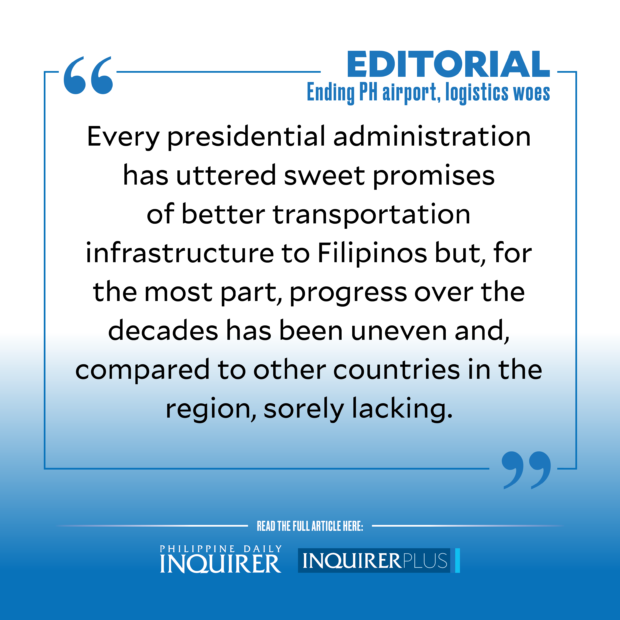Ending PH airport, logistics woes

But the indirect casualties—figuratively speaking—are difficult to quantify and will almost certainly amount to billions of pesos in economic damage to the Philippines’ second largest metropolis, no thanks to the cancellation of hundreds of arriving and departing flights over two days, affecting thousands of passengers and several hundreds of tons of precious, perishable cargo that are moved by air.
The incident not only highlighted the importance of aviation as a key component of moving goods and people around the country’s vast archipelago, it also emphasizes just how important the issue of logistics is to keep the Philippine economy running smoothly and connected with the rest of the world.
Article continues after this advertisementAnd when it comes to logistics, we can truly say that this country has fallen short of what needs to be done to connect over 7,000 islands into one single community that will help Filipino farmers in Mindanao sell their produce for a fair return on their efforts of growing them and getting them expeditiously and efficiently to consumers in cities all over the country at reasonable costs.
Every presidential administration has uttered sweet promises of better transportation infrastructure to Filipinos but, for the most part, progress over the decades has been uneven and, compared to other countries in the region, sorely lacking.
More alarmingly, the latest news to emerge regarding the issue of building badly needed infrastructure came early this week with the announcement by billionaire businessman Manuel Pangilinan that his conglomerate is no longer interested in joining the effort to rehabilitate the country’s most important aviation hub, the Ninoy Aquino International Airport (Naia).
Article continues after this advertisementAnd who can blame him? Since the 1990s, presidents have wooed private investors to plunk in the billions of pesos needed to improve the facilities at Naia, rebuild crumbling passenger terminals, and even build an additional runway to help ease the constant problem of airplanes experiencing the equivalent of traffic logjams both in the sky and on the tarmac. Despite all the best efforts of presidents through the years, Naia remains essentially unchanged, limping by year to year, thanks only to cosmetic changes and marginal improvements to efficiency.
In recent history, Naia has defied at least three serious attempts to improve things, leaving the status quo victorious in all three instances. If an astute businessman like Pangilinan thinks the effort is no longer worth his time and capital, it is a worrying signal for the Marcos Jr. administration, who has said it will prioritize the use of private investors’ resources to fund the country’s infrastructure buildup program, since the pandemic basically resulted in the Philippine government “maxing out” its credit card already.
Thankfully, the leadership of the Department of Transportation seems to understand the urgency of the problem and has put the issue of improving the country’s inadequate air, sea, and land infrastructure front and center as far as its program of priorities is concerned.
It is encouraging that Transportation Secretary Jaime Bautista wants to improve not only the country’s airports, but seaports as well, which—along improvements in the country’s road network that the Department of Public Works and Highways can facilitate—will translate to a vast improvement in the local logistics scene. Most importantly, it will translate to cheaper goods and services for millions of citizens currently suffering from record-high inflation.
This is especially important given the country’s experience since the start of the pandemic where logistics—whether it is transporting millions of vaccines to the country from overseas, or having goods or food bought online delivered to one’s doorstep—has proven to be a life and sanity saver for millions of Filipinos.
Our hope is that President Marcos Jr. applies the substantial political capital he currently has toward clearing the figurative roadblocks that currently deter private investors from committing their resources to improving the Philippines’ old airports, seaports, and highways, or building new ones. Without a sustained push from the Chief Executive, it is likely that the status quo will win again, as it has all these years.
















